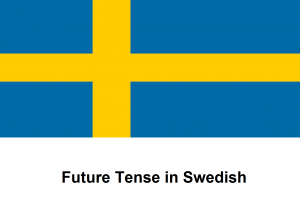Language/Swedish/Grammar/Future-Tense
 Հայերէն
Հայերէն Български език
Български език 官话
官话 官話
官話 Hrvatski jezik
Hrvatski jezik Český jazyk
Český jazyk Nederlands
Nederlands English
English Suomen kieli
Suomen kieli Français
Français Deutsch
Deutsch עברית
עברית हिन्दी
हिन्दी Magyar
Magyar Bahasa Indonesia
Bahasa Indonesia فارسی
فارسی Italiano
Italiano 日本語
日本語 Қазақ тілі
Қазақ тілі 한국어
한국어 Lietuvių kalba
Lietuvių kalba Νέα Ελληνικά
Νέα Ελληνικά Şimali Azərbaycanlılar
Şimali Azərbaycanlılar Język polski
Język polski Português
Português Limba Română
Limba Română Русский язык
Русский язык Српски
Српски Español
Español العربية القياسية
العربية القياسية Wikang Tagalog
Wikang Tagalog தமிழ்
தமிழ் ภาษาไทย
ภาษาไทย Türkçe
Türkçe Українська мова
Українська мова Urdu
Urdu Tiếng Việt
Tiếng ViệtSwedish has four different verb forms to express the future: "future present", "ska", "tänker", and "komma att".
These forms are used differently depending on the context, and this lesson will explain when to use each form. By the end of this lesson, you will have a better understanding of how to use these different verb forms to express the future in Swedish.
Future present of the verb (=present)[edit | edit source]
The future present of the verb is identical with the present time of the verb, but is meant and translated as future tense.
The future present can be used in most cases:
Jag skriver en svensk lektion på kvällen. (context: I just got up from bed this morning, I am going to do this in the evening. It is thus clear for everybody that this is about future) / I am going to write a Swedish lecture this evening.
But note the difference in meaning, while the verb is staying in the same form, but in this case it is present time: Jag skriver en lektion nu. (context: I am just sitting and writing this lecture for you, right now).
Ska + Infinitiv of verb[edit | edit source]
Jag ska skriva en svensk lektion på kvällen. / I am going to write a Swedish lecture this evening.
After auxiliary verb “ska” comes always the infinitive of the verb (without “att”, in this case “skriva”).
Also possible and often used, but inte so often as “present future”.
Personally I think that using present future is more comfortable in speeches and therefore used more often.
Here I also have a definite plan, I am (definitely) going to write the lecture this evening. (context: I have time for it, all is prepared).
Tänker + Infinitiv of verb[edit | edit source]
Jag tänker skriva en svensk lection på kvällen. / I might be going to write the lecture this evening. (Nothing is yet prepared, I might have time for it, Imight not have time for etc.).
After “tänker” comes always the infinitive of the verb (without “att”, in this case “skriva”).
But note the difference in meaning to the use of “ska”: Here I have no (!) definite plan, I just have the wish to write a Swedish lecture, but it is unsure if I do so. Nothing is prepared and it can be that I have no time for it this evening and do it at another, not defined time and date.
There are further possibilities to use the verb “att tänka/to think”. You will find more information about it in my lecture “att tycka, att tänka, att tro”.
Komma att[edit | edit source]
If it is something in the future, we have no control over, it happens.
Komma att is therefore for example used with the weather.
Det kommer att regna idag. / It will rain today.
Examples[edit | edit source]
| ENGLISH | SWEDISH |
|---|---|
| I will love | Jag skall älska |
| You will love | Du skall älska |
| He will love | Han skall älska |
| We will love | Vi skall älska |
| You will love | Ni skall älska |
| They will love | De skall älska |
| I will speak | Jag skall tala |
| You will speak | Du skall tala |
| He will speak | Han skall tala |
| We will speak | Vi skall tala |
| You will speak | Ni skall tala |
| They will speak | De skall tala |
| I will sleep | Jag skall sova |
| You will sleep | Du skall sova |
| He will sleep | Han skall sova |
| We will sleep | Vi skall sova |
| You will sleep | Ni skall sova |
| They will sleep | De skall sova |
| I will open | Jag skall öppna |
| You will open | Du skall öppna |
| He will open | Han skall öppna |
| We will open | Vi skall öppna |
| You will open | Ni skall öppna |
| They will open | De skall öppna |
Author[edit | edit source]
https://polyglotclub.com/member/Ljus
Videos[edit | edit source]
Learn Swedish Future tense - Swedish grammar - YouTube[edit | edit source]
Future Tense in Swedish - Ska vs. Kommer att - YouTube[edit | edit source]
Other Lessons[edit | edit source]
- Personal pronouns
- Passive Voice
- Sentense Structure
- Indefinite Articles in Swedish
- Past Tense
- Possessive Case in Swedish
- Imperative Tense
- Location
- How to Use Have
- How to Talk About the Weather

